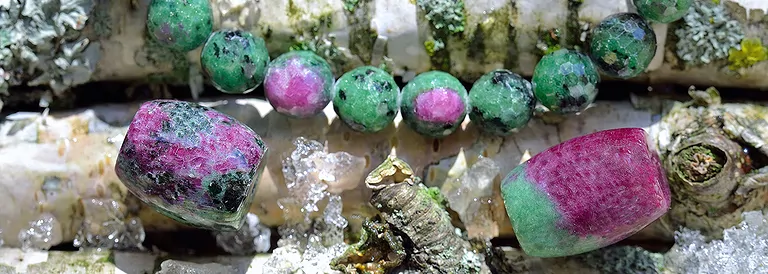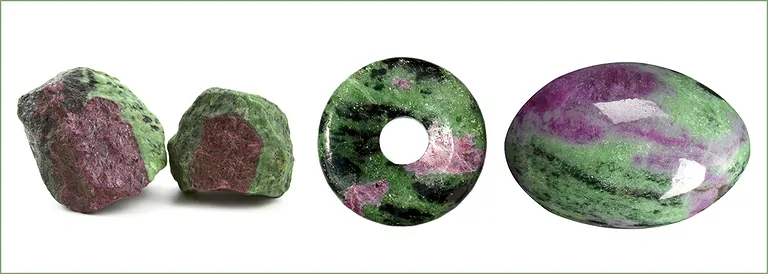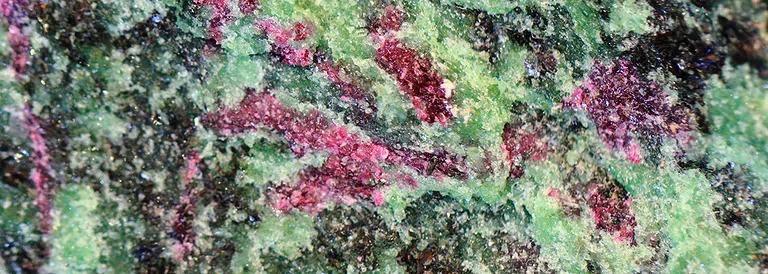
Stone of the Month June 2025: Zoisite Ruby - Meaning and bearing of a two-tone gemstone
Light and warmth have finally overcome cold and darkness. Nature gives us sunshine and full bloom, it is humming and buzzing everywhere. Colors and scents fill nature around us. We have been able to achieve a lot already and have thus created a good basis for positive developments and further growth.
Zoisite with Ruby supports us when we adapt too much and are determined by the outside.The own wishes and ideas come to light with the help of the stone clearer and can then be implemented with energy and creativity. If we are too much digressed by interruptions and detours, the Zoisite Ruby helps us back on our own way to the goals that we actually want to achieve.
Zoisite items and wholesale prices: focal components, stringed beads, jewelry and much more
History of the discovery of zoisite
Zoisite is, mineralogically speaking, a late bloomer, because the mineral was found only at the end of the 18th century the first time in Carinthia / Austria and named after the mineral collector Karl Sigismund Zois. He had sent a team of mineral collectors to the neighboring Duchy of Kärtnten (Austria) around the turn of the century. From the Saualpe located there, the discoverers brought back a previously unknown mineral. Zois first named this mineral after the place where it was found "Saualpit" later the stone was named Zoisite in his honor. THE extensive mineralogical and geological collection of Zois can be seen today in the Slovenian Museum of Natural History in Ljubljana.
Varieties and synonyms of zoisite
The blue variety of zoisite is called tanzanite, another name for tanzanite occasionally found in retail and wholesale is anyolite (derived from the Masai word for green) for zoisite with ruby from Tanzania. Other synonyms are illuderite, orthozoisite, saualpite or sau-alpite (see ‘Discovery of zoisite’) and unionite. The intensely pink-coloured variety of zoisite is called thulite.

Mineralogical profile of Zoisite
Chemical formula: Ca2Al3[O/OH/SiO4/Si2O7]
Mineral class: Group silicate
Formation: in the metamorphic alteration of basic igneous rocks to calc-silicate, greenschist or eclogite rocks
Color: gray, brown to greenish, due to chromium content íntensive green
Gloss: vitreous luster
Crystal system: rhombic
Mohs hardness: 6 to 6.5
Cleavability, fracture: perfect splitability, uneven fracture
Localities, main supplying countries: worldwide from Norway to Antarctica, Austria (see ‘Histroy of the discovery of zoisite’); today almost exclusively from Tanzania
Appearance: mostly granular masses; also coarse, broad-stemmed, radiating aggregates; rarely only prismatic crystals, which are often stretched, bent, kinked and broken in the rock ingrown
Use: Zoisite is processed mainly as green, sometimes ruby-containing rock from Tanzania (anyolite) to jewelry and art objects.
Use of zoisite in gemstone healing
Zoisite is one of the most important gemstones for regeneration after difficult phases in life. The gemstone can help to overcome a passive, destructive attitude and take life back into one's own hands. It helps you to develop your own ideas and wishes and then implement them step by step. This makes it possible to break free from conformity and heteronomy. Buried and lost ideas can come to light again. Zoisite should be worn or placed on the body over a longer period of time, e.g. as a drilled tumbled stone or bracelet.
Zoisite with ruby is often used in gemstone wellness, as the mineral combines the effects of both components. The classic uses of the stone are applications that promote regeneration and - due to the “love stone” ruby - also partner massages.
